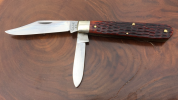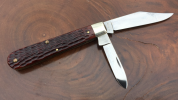waynorth
Dealer / Materials Provider
- Joined
- Nov 19, 2005
- Messages
- 33,329
They are 4 11/16", Jeff. Pretty substantial!Cool pattern, Charlie, a mid-locking saddlehorn! How long are they?
The BladeForums.com 2024 Traditional Knife is available! Price is $250 ea (shipped within CONUS).
Order here: https://www.bladeforums.com/help/2024-traditional/
They are 4 11/16", Jeff. Pretty substantial!Cool pattern, Charlie, a mid-locking saddlehorn! How long are they?


Wow! That sure is a winner!"Black Friday" Old Knives edition
Something about the blades on this knife just made me think "winner" and I had to have it...
AW Bradshaw & Sons Germany, very strong snap and half stop on both blades... certainly lives up to the stamp on the main blade
View attachment 836395 View attachment 836396 View attachment 836397 View attachment 836398 View attachment 836399
- V_P

With a nod to LongBlade's scholarly post, here is a picture with bit more meat involved.
Enclosed is a 100 year old Wilbert folding guard lock-back model with dark stag handles. Wilbert was a trade-mark of the Sears & Roebuck hardware company and was used from c.1908 to 1921.
Sears & Roebuck had used their own name on knives prior to the Wilbert name and it is unclear why they changed to the Wilbert name. Wilbert knives were all made on contract for Sears & Roebuck, but there is some evidence that Sears & Roebuck produced their own knives for a very short time around 1900. It has been suggested that the bulk of the Wilbert knives were made by both Napanoch and Empire, but I have never seen a folder like this one from either of those cutlery companies. A few pages back, galvanic posted a very nice similar model with a Utica blade stamp and I believe Utica was the contract company for this Wilbert. Utica was commonly known to contract more knives out to other companies than for themselves, and perhaps it's possible that other Wilbert knives were made by Utica in the early 1900s. Wilbert, while not well known, offered a wide range of folding knives in various patterns.
The Wilbert knife and a Sears & Roebuck catalog ad from 1912.
View attachment 835837
View attachment 835838


Hey! I did offer a Tenner my friend!Man...Just look at the Bone on That one! Great Knife- Swing Guard or not Lambertiana! The Knife looks to have had little use! Bargain all day long for what you paid my friend!
Awesome Knives Ladies and Gentleman,


Man those are beauties Charlie!!!View attachment 836259 View attachment 836260 Here are two Napanoch-made Wilberts. I found one on the world-reknownedauction site, and traded for the other at a meeting of our mini-knife club. (we are small, but we don't just trade mini-knives!
).
That Utica-made is very cool, herder!
View attachment 836259
"Black Friday" Old Knives edition
Something about the blades on this knife just made me think "winner" and I had to have it...
AW Bradshaw & Sons Germany, very strong snap and half stop on both blades... certainly lives up to the stamp on the main blade
View attachment 836395 View attachment 836396 View attachment 836397 View attachment 836398 View attachment 836399
- V_P
Before I read your post, I thought that your knife looks a lot like my Utica (mine is missing the swing guard, but you can see the hole where it was originally). I posted this recently, but it's fitting to show it again. I got it for just over 10X the catalog price for your Wilbert, so Duncan is underbidding by about a dollar (I paid $10)

Truly magnificent Charlie !!View attachment 836259 View attachment 836260 Here are two Napanoch-made Wilberts. I found one on the world-reknownedauction site, and traded for the other at a meeting of our mini-knife club. (we are small, but we don't just trade mini-knives!
).
That Utica-made is very cool, herder!
View attachment 836259
Thanks, Campbellclanman (temping offer), LongBlade, galvanic, and waynorth.
A couple of beautiful Wilbert saddle horn models, waynorth. Here is an ad also from 1912, and I smile at the first sentence following the model description.
Heck of a knife for well under a dollar.
View attachment 836389
Thanks Herder... I put the Goins excerpt in there to see if anyone would mention the AW Bradshaw & Sons knife doesn't look 150 years oldNice old knife which dates to the early 1900s.
I suspect that a lot of older research was based on incomplete records and encountering a few examples and trying to piece together a timeline. Threads such as this one, may perhaps give us a much wider shared reference sample than was available even to the most ardent scholars a generation ago.I read that AW Bradshaw being an importer and the fact that blades are stamped "Germany" are both indicators that the knife was manufactured in the 1890's to early 1900's... does anyone have reference material or other explanation for why this is? Goins includes the "Germany" portion in the encyclopedia excerpt so are the dates wrong?

 Have not had the time to really sit and enjoy this section of BF. Finally had a leisurely hour to play on this site and just wanted to share what I'm sure a lot of my fellow knifeaholics feel and that it is such an enjoyable experience to get on here and see all the beautiful old knives and learning some new history and facts. And after missing it for a couple of days it is just extra enjoyable to immerse yourself in all of the antique knives and newly shared research. I have learned so much from everyone here and thank all the great contributors to this thread. This is my favorite section of BF. I was in my favorite knife store the other day and ran across this 1940 to 1964 6202-1/2 and had to have it. It is just on this side of being mint. Great walk and talk. The perfect pull for me on both blades. It's going to have to go in the pocket. I know it's not that old but I felt like it would fit in well here. Thanks again everyone.
Have not had the time to really sit and enjoy this section of BF. Finally had a leisurely hour to play on this site and just wanted to share what I'm sure a lot of my fellow knifeaholics feel and that it is such an enjoyable experience to get on here and see all the beautiful old knives and learning some new history and facts. And after missing it for a couple of days it is just extra enjoyable to immerse yourself in all of the antique knives and newly shared research. I have learned so much from everyone here and thank all the great contributors to this thread. This is my favorite section of BF. I was in my favorite knife store the other day and ran across this 1940 to 1964 6202-1/2 and had to have it. It is just on this side of being mint. Great walk and talk. The perfect pull for me on both blades. It's going to have to go in the pocket. I know it's not that old but I felt like it would fit in well here. Thanks again everyone.Thanks Herder... I put the Goins excerpt in there to see if anyone would mention the AW Bradshaw & Sons knife doesn't look 150 years oldI'll take early 1900's, I think that still qualifies as "Old"
I guess I don't really follow why Goins (and other sources) has that AW Bradshaw & Sons Germany stamp only existing up to 1860 but the knife appears to be manufactured long after that. I read that AW Bradshaw being an importer and the fact that blades are stamped "Germany" are both indicators that the knife was manufactured in the 1890's to early 1900's... does anyone have reference material or other explanation for why this is? Goins includes the "Germany" portion in the encyclopedia excerpt so are the dates wrong? Are the blades original and knife assembled at a later date? Are they flat out forgeries using the Bradshaw stamp? Either way I am happy with the knife
- Curious in Wisconsin (Kevin)
